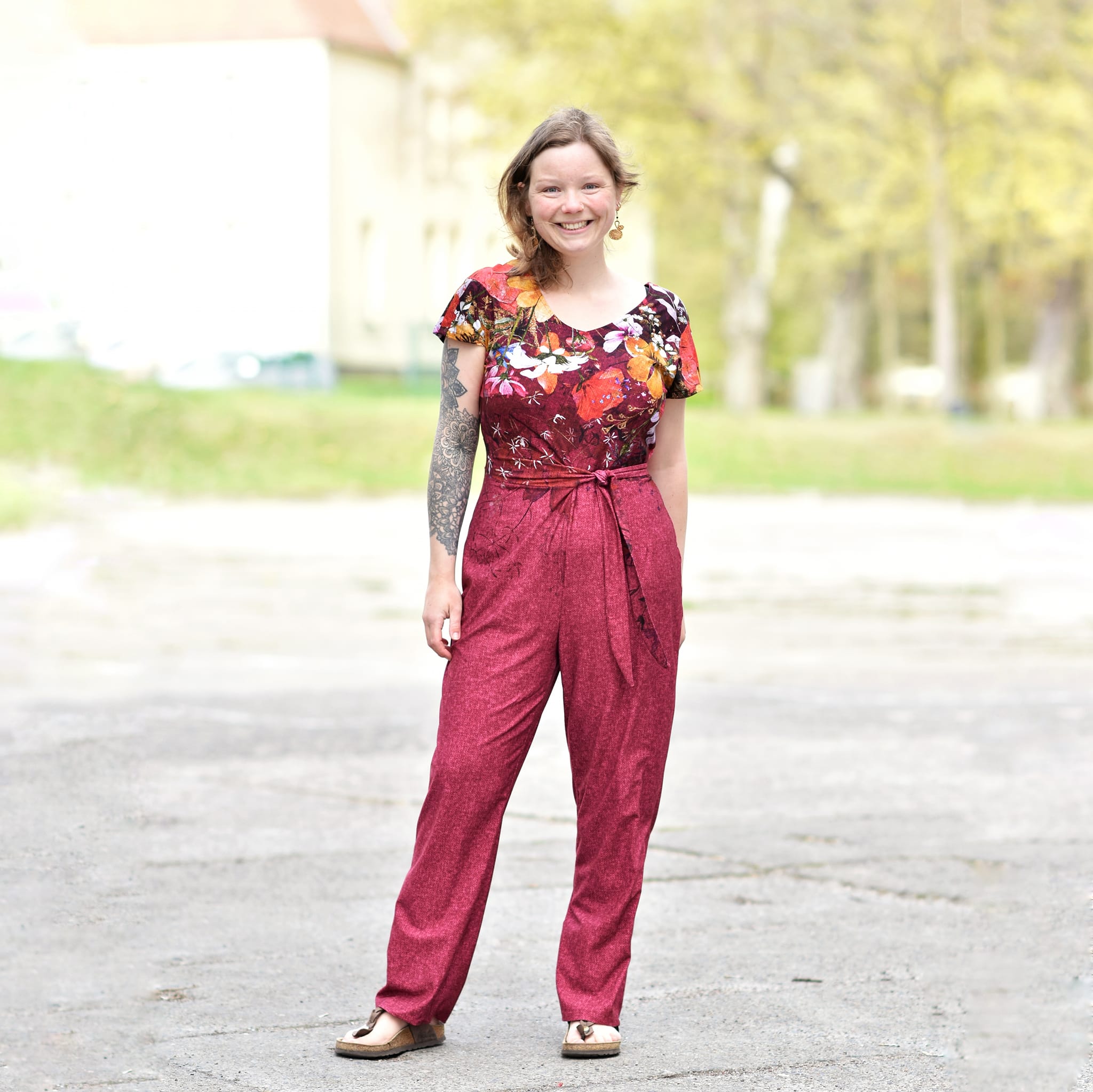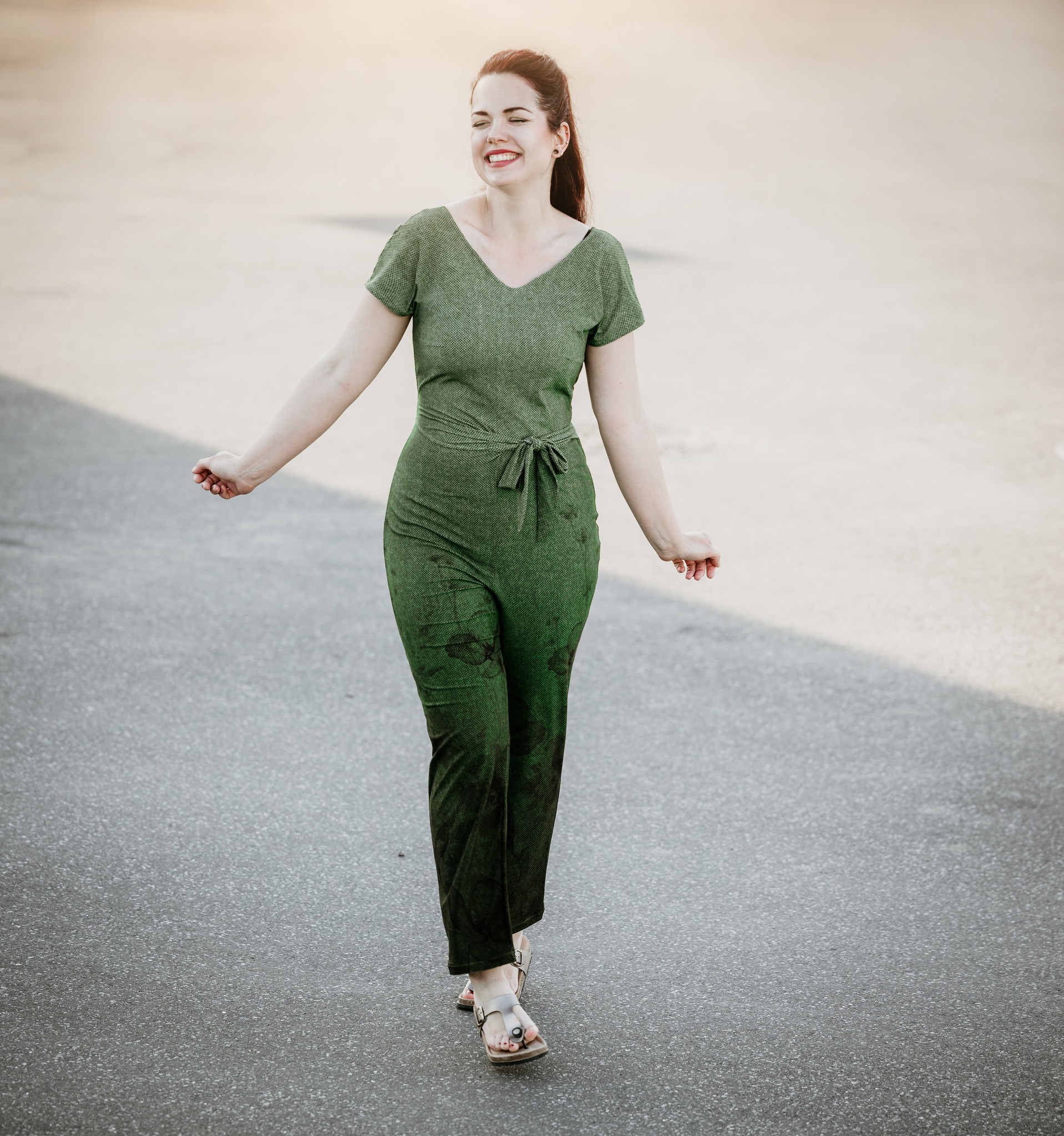zum Warenkorb 0,00 €
0Nähanleitung /// How to sew: Neptun
Neptun
Der Jumpsuit Neptun besticht durch das wunderschöne Knotendetail in der Taille. Brustabnäher sorgen für einen perfekten Sitz. Überschnittene, lockere Ärmel machen Neptun zum perfekten Sommerbegleiter.
Neptun
The Neptun jumpsuit impresses with its beautiful knot detail at the waist. Bust darts ensure a perfect fit. Loose sleeves make Neptun the perfect summer companion.
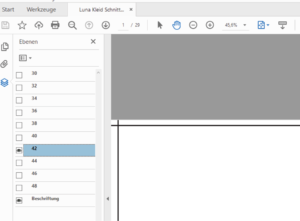
Richtige Größe drucken
Print the correct size
Maßtabelle /// Size chart (cm)

Legeplan bei Bordürenstoffen /// Laying plan for border fabrics
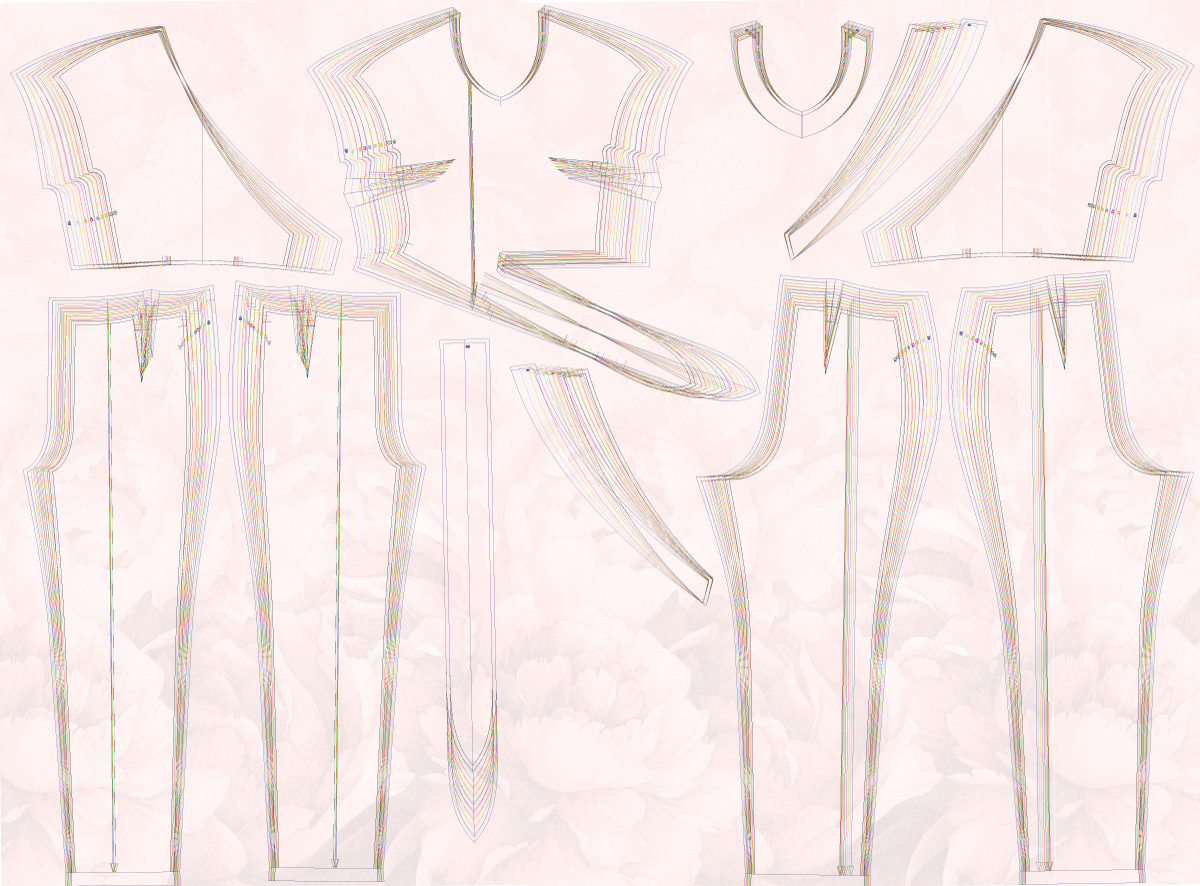
Stoffbedarf Bordürenstoffe /// Fabric requirement border fabrics (cm)

Stoffempfehlung
Für Neptun eignen sich am besten Stoffe mit weichem Fall, wie unser Viskosejersey. Der Stoff sollte mindestens 5% Elasthananteil haben.
Fabric recommendation
Fabrics with a soft drape, such as our viscose jersey, are best suited for Neptun. The fabric should have at least 5% elastane.
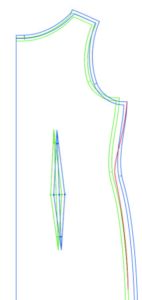
Anpassung
Nähe unbedingt ein Probeteil aus einem günstigen Stoff. Jumpsuits verzeihen deutlich weniger Fehler als Kleider. Da Schnitte immer genormt sind, unsere Körper jedoch nicht, ist eine Anpassung oft notwendig. Für dieses Schnittmuster sind alle drei Maße relevant: Brustumfang, Taille und Hüfte. Weichen die Maße voneinander ab, muss unbedingt angepasst werden.
Bei Neptun ist es extrem wichtig, dass der Knoten genau in der Taille sitzt. Solltest du also einen seht langen oder kurzen Oberkörper haben solltest du unbedingt deine Taillenlänge ausmessen. So gehst du dafür vor: von der höchsten Stelle der Schulter (da, wo die Schulternaht sitzt) über die Brustspitze zum unteren Rand des Taillenbandes. Vergleiche diese Länge mit dem Schnittmuster. indem du hier auf der Seite ohne Band von der Schulter aus über den Brustpunkt Abnäherspitze) bis zur Taille misst. Verlängere oder kürze dann entsprechend Vorder- und Rückteil zwischen Abnäher und Band.
Der Schnitt enthält bereits Brustabnäher. Solltest du allerdings eine sehr große Brust haben, kann eine FBA nötig sein. Infos zum Thema FBA findest du hier.
Bei einem Jumpsuit ist auch die Schrittlänge extrem wichtig. Miss unbedingt deine Kreuznaht aus, damit diese Strecke lang genug für deinen Körper ist. Die Kreuznaht führt vom Taillenbund vorne zwischen deinen Beinen hindurch zum Taillenbund hinten. Die Hose von Neptun soll im Schritt locker sitzen und nicht eng anliegen.
Wenn du den Schnitt anpassen musst, weil du zwischen 2 Größen bist, drucke nur die Größen, die du zum Verbinden benötigest. Zum Beispiel Brust 40, Hüfte 36.
Verwende die Ebenenfunktion und drucke nur 40 und 36 aus.
Die Größen werden dann mit einer Linie verbunden, im Beispielbild ist es die rote Linie.
Solltest du Hilfe benötigen, schau gern in der Mondstoff-Gruppe auf Facebook vorbei: Mondstoff-Gruppe
Adjustment
Be sure to sew a sample piece out of a cheap fabric. Jumpsuits are far more forgiving than dresses. Since patterns are always standardized, but our bodies are not, an adjustment is often necessary. All three measurements are relevant for this pattern: bust, waist and hips. If the measurements deviate from each other, it is essential to adjust them.
With Neptune, it is extremely important that the knot sits at the waist. So if you have a very long or short torso, you should definitely measure your waist length. This is how you do it: from the highest point of the shoulder (where the shoulder seam sits) over the breast point to the lower edge of the waistband. Compare this length with the pattern. By measuring here on the side without tie from the shoulder over the bust point (end of the dart) to the waist. Then lengthen or shorten the front and back sections between the dart and the tie accordingly.
The pattern already includes bust darts. However, if you have a very large breast, an FBA may be necessary. Information about FBA can be found here.
With a jumpsuit, the inseam length is also extremely important. Be sure to measure your cross seam so this seam is long enough for your body. The cross seam runs from the waistband at the front between your legs to the waistband at the back. Neptun pants should be loose in the crotch and not tight.
If you need to adjust the pattern, you can only print the sizes you need to connect. For example, top chest 40, hips 36.
Use the layers function and only print out 40 and 36.
The sizes are then connected with a line, in the example image it is the red line.
If you need help, feel free to join the Mondstoff group on Facebook: Mondstoff Group
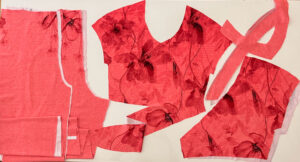
Zuschnitt
1 x Oberteil vorne
2 x Rückenteil gegengleich (entscheide dich für Variante 1 oder 2)
1 x vorderer Beleg im Bruch
2 x hinterer Beleg gegengleich (Variante 1 oder 2)
2 x Vorderhose gegengleich
2 x Hinterhose gegengleich
1 x Taillenband
Cutting
1 x fronttop
2 x backtop mirrored (choose option 1 or 2)
1 x front facing mirrored
2 x back facing mirrored (option 1 or 2)
2 x front trousers mirrored
2 x back trousers mirrored
1 x tie

Passzeichen übertragen
Übertrage alle Passzeichen mit Hilfe eines Trickmarkers oder ähnlichem auf die linke Stoffseite.
Transfer the marks
Transfer all marks to the wrong side of the fabric using a trick marker or something similar.
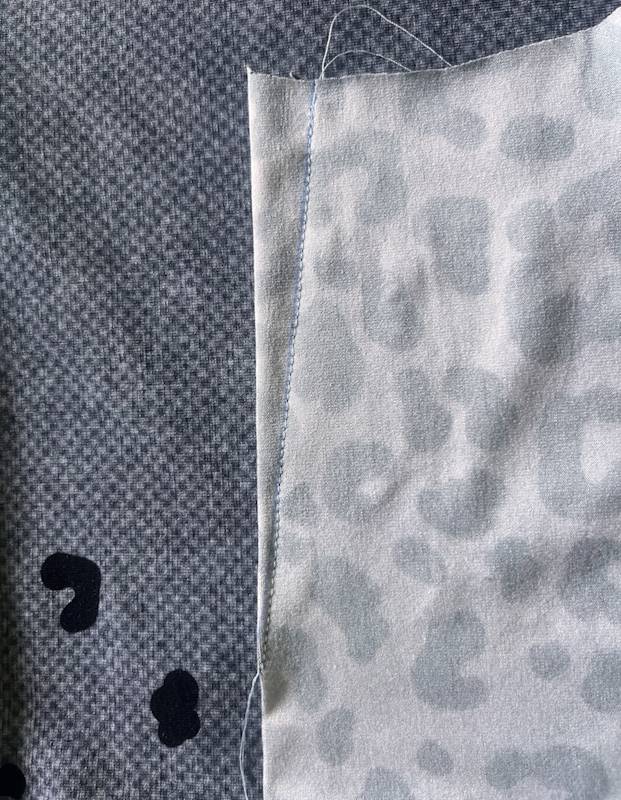
Abnäher schließen
Schließe am Vorderteil des Oberteils sowie an der Vorder- und Hinterhose die Abnäher, indem du mit einem kurzen Geradstich in Richtung Abnäherspitze nähst. Verriegele das Ende der Naht nicht und verknote die Enden gründlich.
Closing the darts
Close the darts on the fronttop and on the front and back trousers by sewing with a short straight stitch in the direction oft the dart tip. Don´t lock at the end of the seam and knot the ends thoroughly.
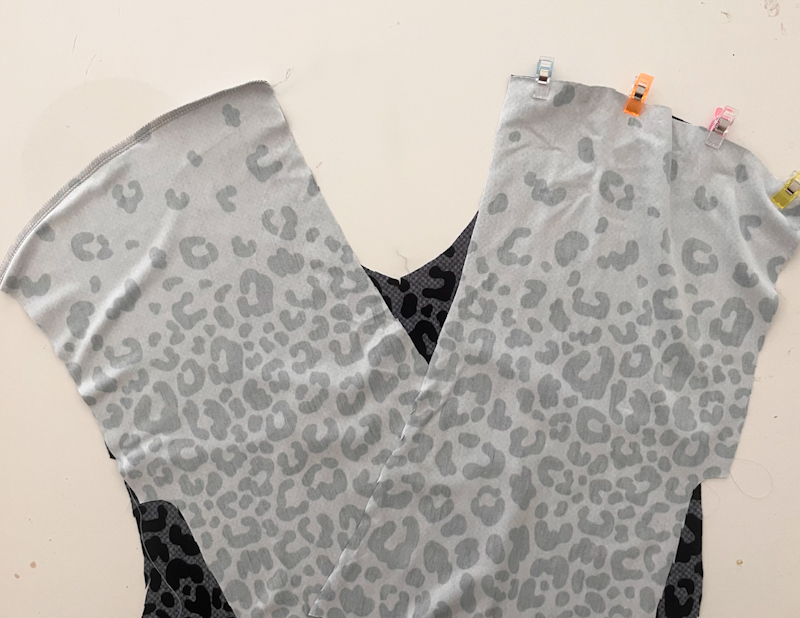
Schulternähte schließen
Schließe beide Schulternähte.
Closing the shoulderseams
Sew both shoulder seams.
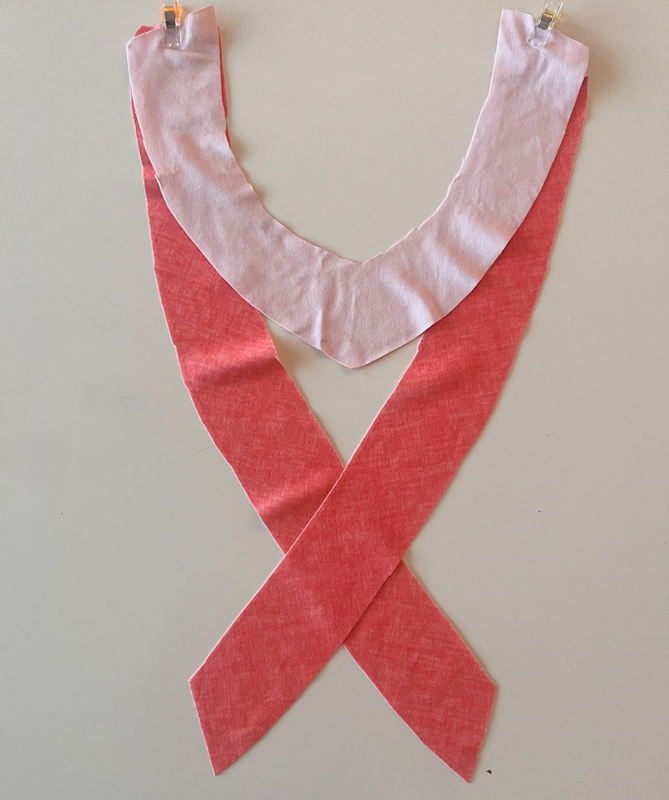
Beleg vorbereiten
Lege die beiden hinteren Belege rechts auf rechts auf den vorderen Beleg und schließe die Nähte mit einem elastischen Stich. Optional kannst du die äußere Belegkante mit der Overlock versäubern.
Prepare the facing
Place the two back facings right sides together on the front facing and close the seams with an elastic stitch. Optionally, you can finish the outer edge of the facing with the serger.
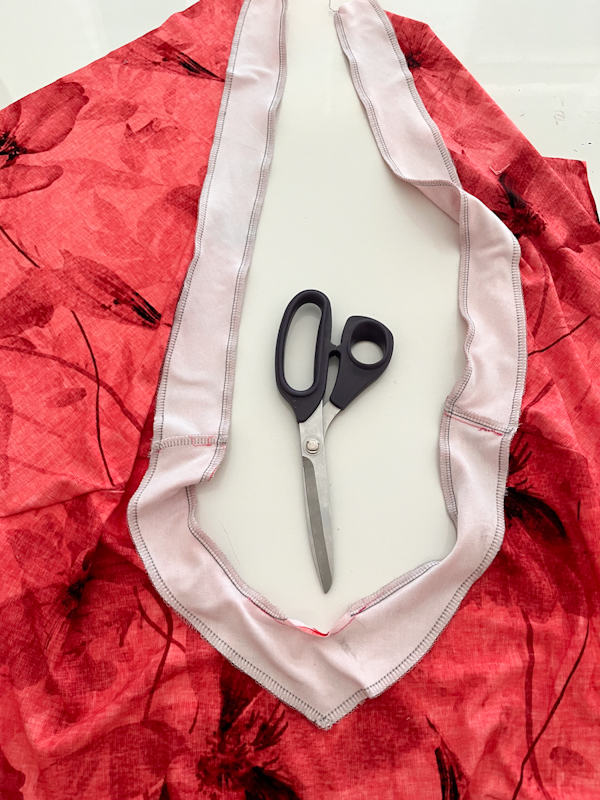
Beleg annähen
Lege den Beleg rechts auf rechts an das geöffnete Oberteil und nähe ihn mit einem elastischen Stich fest.
Sewing the facing
Place the facing right sides together on the open top and sew it in place with an elastic stitch.
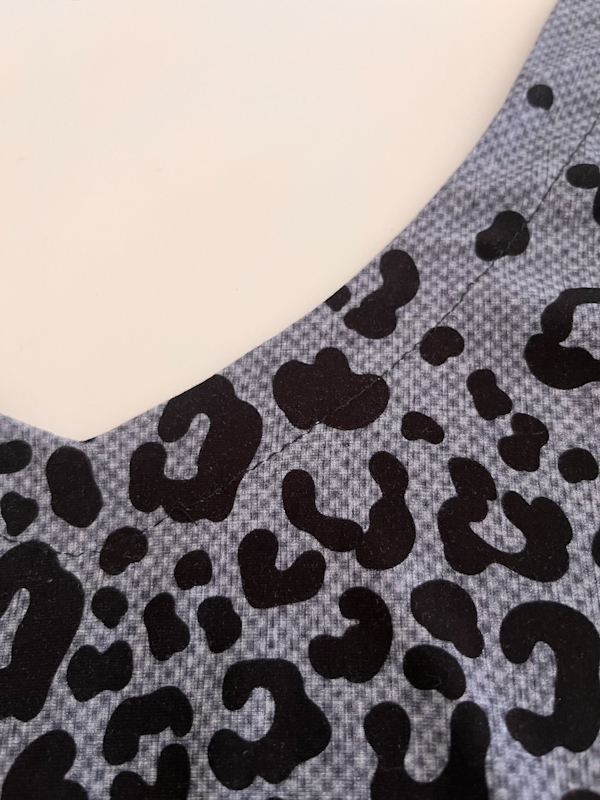
Beleg absteppen
Steppe den Beleg auf der Versäuberungsnaht einmal rundherum ab.
Topstitch the facing
Topstitch the facing all the way around.
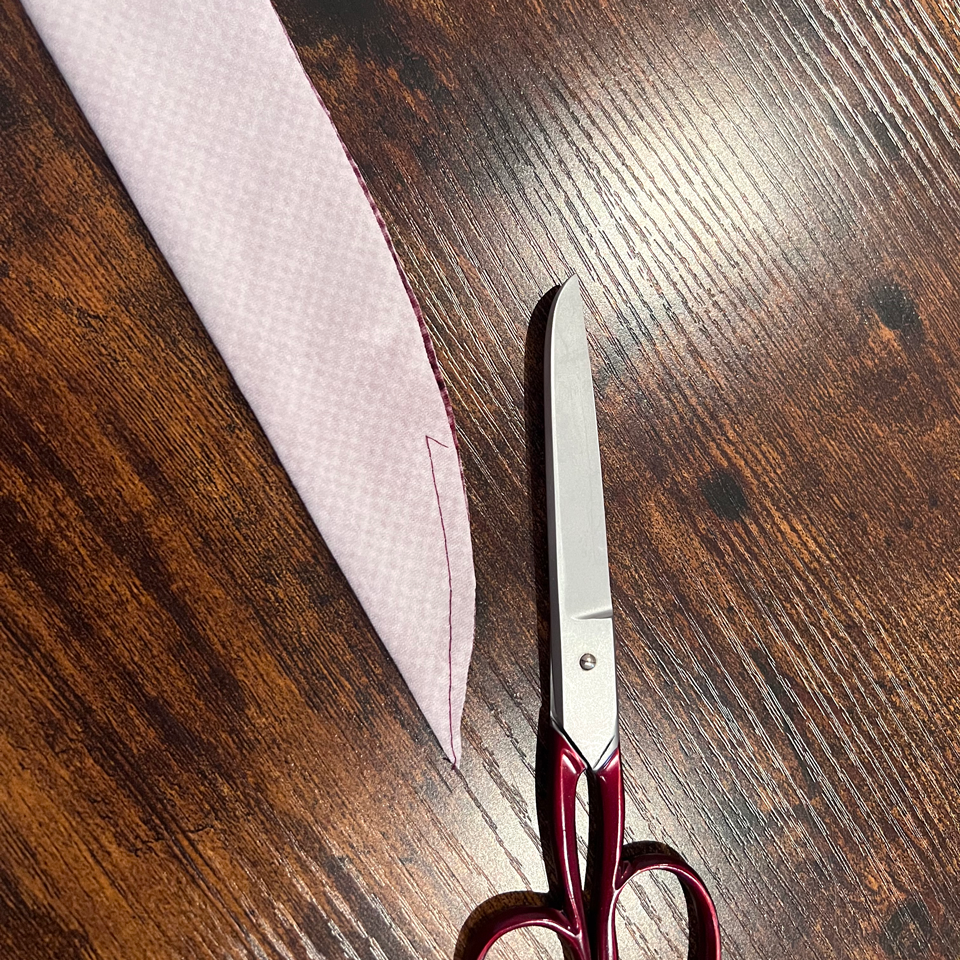
Bindeband vorbereiten
Falte das Band rechts auf rechts und nähe im Bereich der Rundung mit einem engen Geradstich. Schneide die Nahtzugabe hier etwas zurück, wende das Band und bügele es.
Prepare the tie
Fold the tie right sides together and sew around the curve with a tight straight stitch. Cut back the seam allowance here, turn the tie and iron it.
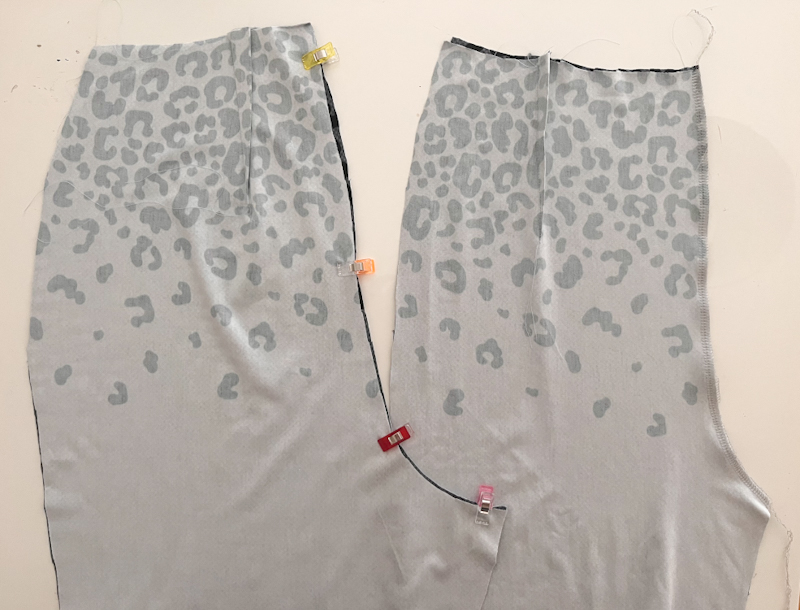
Hose vorbereiten
Schließe sowohl an der Vorder- als auch an der Hinterhose die Schrittnähte.
The trousers
Close the inseams on both the front and back pants.
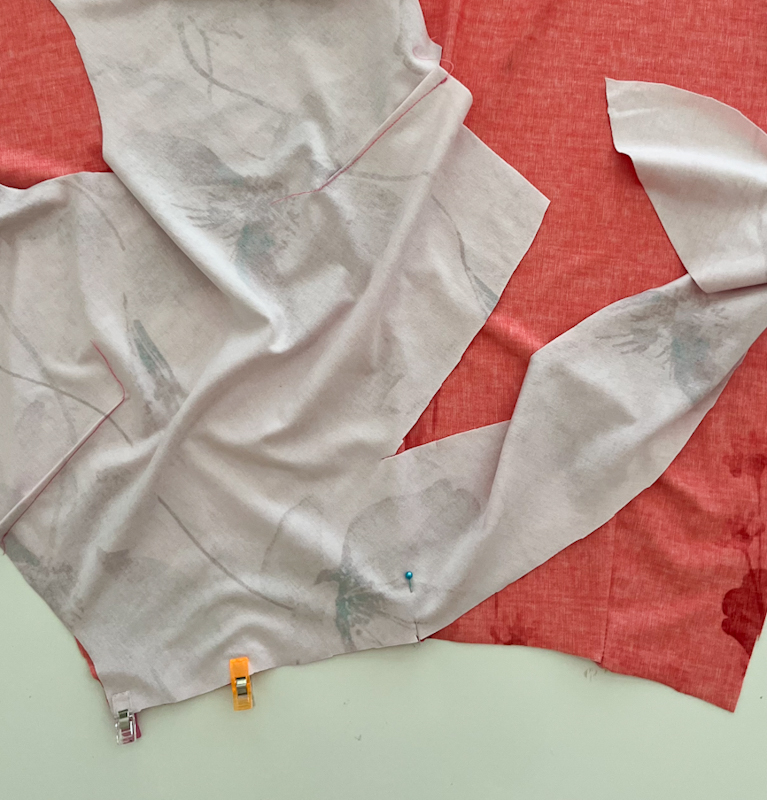
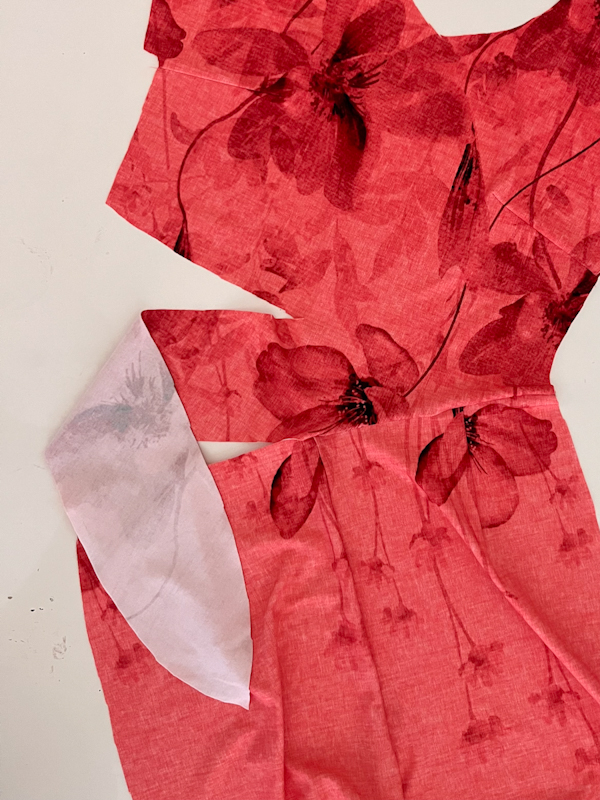
Vorderteil nähen
Lege das Vorderteil rechts auf rechts auf die Vorderhose so wie auf dem Bild. Nähe nun genau bis zur Markierung für die vordere Mitte. Du kannst dies mit der Overlock tun. Die letzten 2 cm solltest du mit einem engen Stich der Nähmaschine nähen und gründlich verriegeln.
Sewing the front
Place the top on the front trousers, right sides together, as shown in the picture. Sew up to the mark. You can do this with the serger. You should sew the last 2 cm with a tight stitch of the sewing machine and backstitch thoroughly.
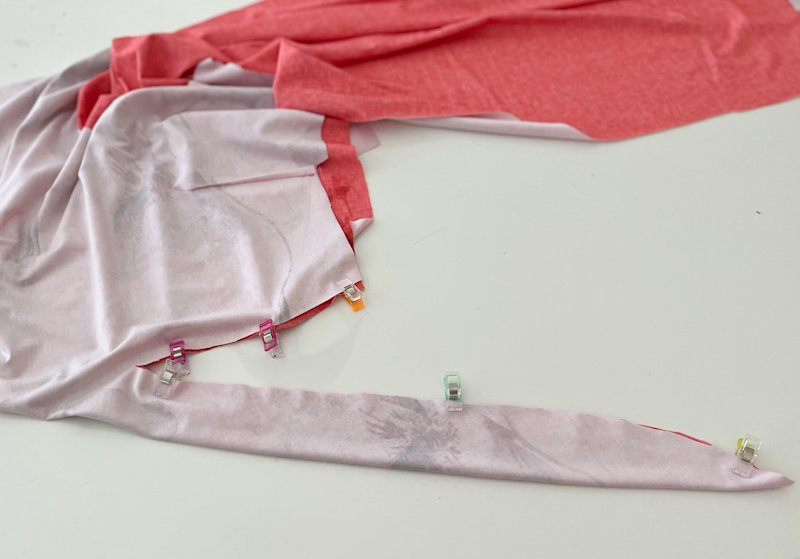
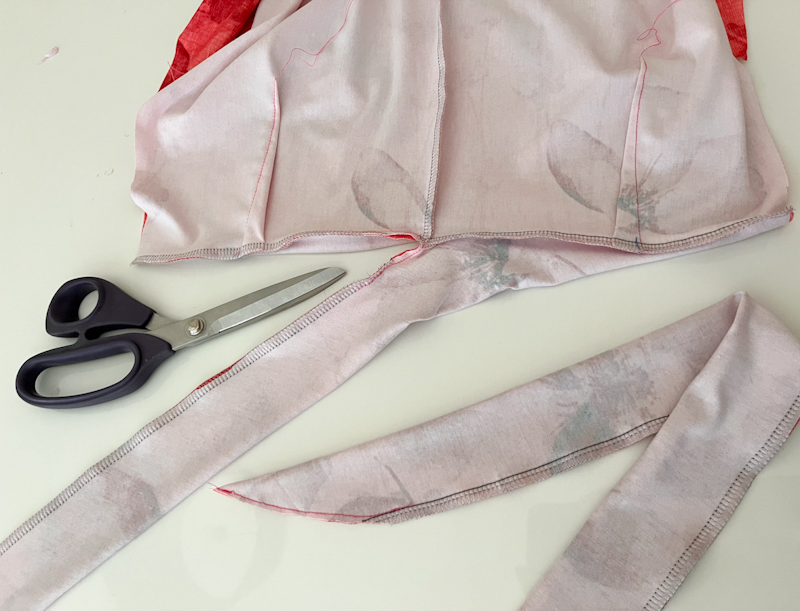
Band am Vorderteil schließen
Lege das Band rechts auf rechts wie auf dem Bild und nähe die Ecke und die Rundung am Band mit einem engen Geradstich, den Rest kannst du mit der Overlock nähen. Schneide die Nahtzugabe im Bereich der Ecke etwas ein und kürze sie im Bereich der Rundung am Band. Wende das Band auf rechts und bügele gründlich.
Closing the tie
Place the tie right sides together as shown in the picture and sew the corner and the curve on the tie with a tight straight stitch, you can sew the rest with the serger. Snip the seam allowance in the corner area and shorten it in the area of the curve on the tie. Turn the tie right side out and iron thoroughly.
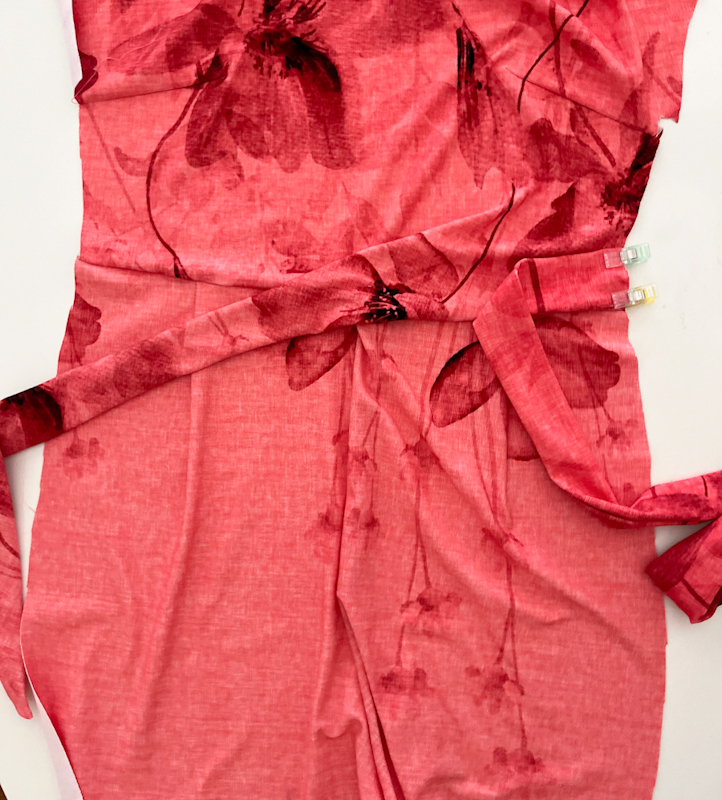
Taillenband annähen
Fixiere das Taillenband auf der Taillennaht wie abgebildet anhand der Markierungen innerhalb der Nahtzugabe.
Fixing the tie
Fix the tie to the waist seam using the marks inside the seam allowance.
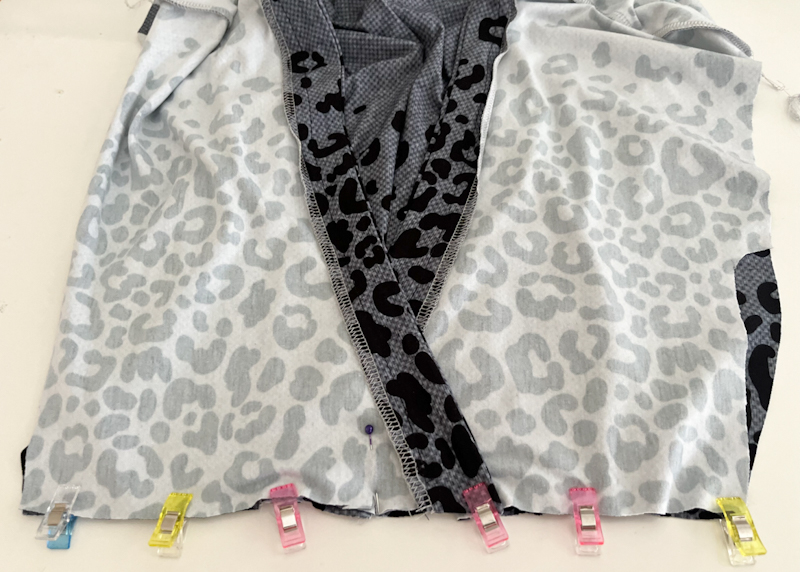
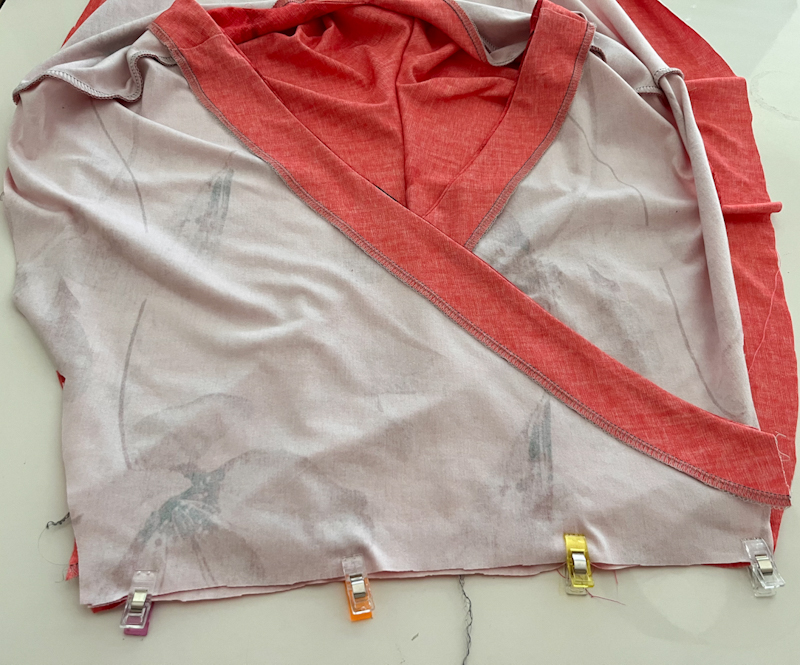
Überlappung am Rücken nähen
Beim Rücken gibt es zwei Optionen:
Variante 1: offener Rücken
Stecke die Rückteile aufeinander, sodass die hintere Mitte aufeinander trifft. Fixiere innerhalb der Nahtzugabe.
Variante 2: geschlossener Rücken
Stecke die Rückenteile anhand der Knipse aufeinander, fixiere die Rückenteile in der Seitennaht innerhalb der Nahtzugabe.
The back
There are two options for the back:
Variant 1: open back
Pin the back pieces together so the center back snaps meet. Fix inside the seam allowance.
Variant 2: closed back
Pin the back pieces together using the snaps, fix the back pieces in the side seam within the seam allowance.

Hinterhose annähen
Stecke das Rückenteil rechts auf rechts an die Hinterhose und nähe mit einem elastischen Stich.
Sewing the back trousers
Pin the back piece to the back pants right sides together and sew with an elastic stitch.
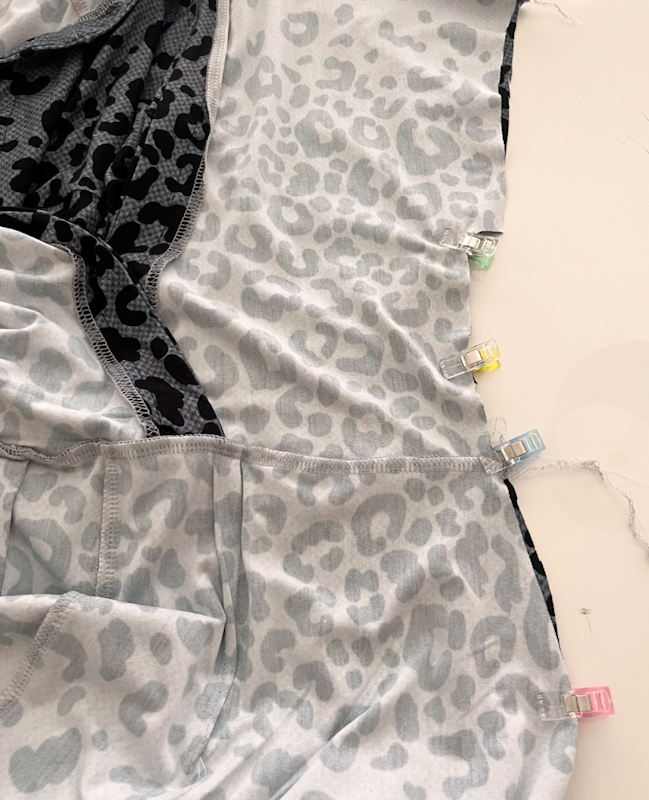
Seitennähte schließen
Lege Vorder- und Rückteil rechts auf rechts und schließe die Seitennähte in einem Rutsch.
Closing the side seams
Place the front and back pieces right sides together and close the side seams in one go.
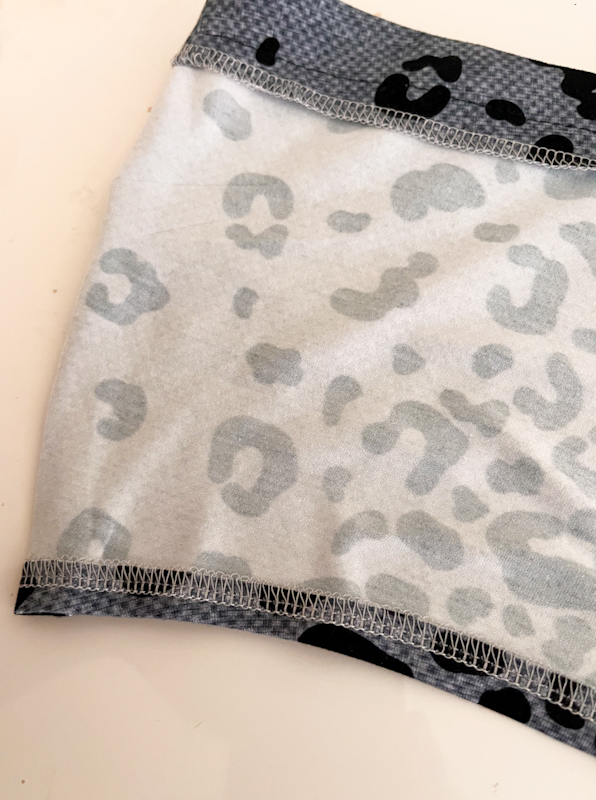
Säumen
Säume den Hosensaum mit 2,5 cm Saumzugabe mit einem elastischen Stich oder einer Zwillingsnadel.
Versäubere die Ärmelausschnittkante mit der Overlock (optional) und säume mit 0,7 cm mit einem elastischen Stich.
Hem
Hem the trousers with a 2.5 cm hem allowance with an elastic stitch or a twin needle.
Finish the armhole edge with a serger (optional) and hem with 0.7 cm with an elastic stitch.

